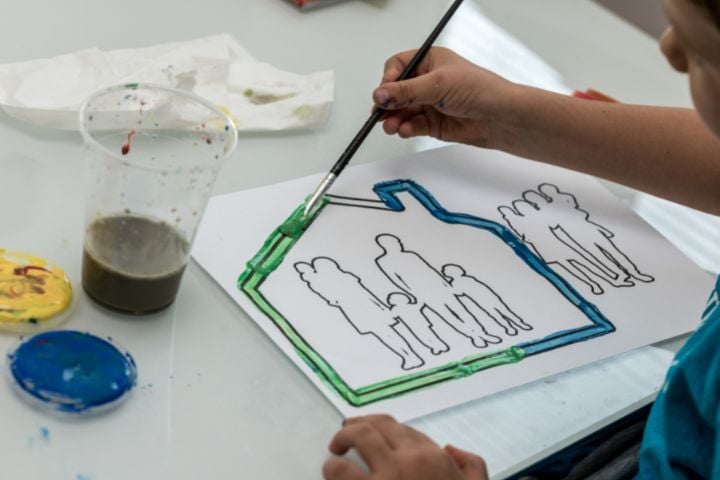
Reducing the Trauma of Removal
Wednesday, August 31st, 2022
Why Reunification and Sibling-Placements Are Crucial to the Well-Being of Children in the Child Welfare System
By Courtney Squires, Summer Intern for the VPLC Center for Family Advocacy, University of Richmond School of Law
To ensure the child welfare system works in the best interest of children, it is important to understand that removal and family separation are traumatic. Research shows that removing children from attachment figures – usually their parents – has long-lasting effects on brain development, and emotional and mental health. Studies of these effects, such as those in the aftermath of the family separation policy at the U.S. border, show that children endure toxic stress when separated from their parents. Toxic stress is the “excessive or prolonged activation of stress response systems in the body and brain,” leading to changes in brain structure that can permanently alter a child’s development and ability to form healthy relationships.
We assume when a child is removed from their home there must be physical and/or sexual abuse, or egregious living conditions. While this is sometimes the unfortunate case, the majority of removals are triggered by findings of “neglect” – a term that is defined differently by every state. Often, “neglect” is a function of oppressive poverty, rather than parental incompetency. When a child is removed from a parent struggling with poverty, without addressing that proverty, an unsuccessful cycle is born – where parents are given confusing (and sometimes endless) hoops to jump through to achieve reunification while their children are left on a carousel of uncertainty.
This is not to say that removal is never warranted – after all, the number one priority of the child welfare system is to protect children – but serving the best interests of the child starts with recognizing the severe impact that removal can have on their life course. In addition to being intentional about family reunification being the primary goal for children in the system, sibling-placements are critical to reducing the traumatic impact of removal. Sibling relationships are often the most enduring relationships in a person’s lifetime, and placing siblings together in the child welfare system preserves cultural identity and provides a sense of continuity for the children and their family. Federal law requires states to make “reasonable efforts” to place siblings together during their time in the child welfare system, but fails to expand on what efforts qualify as “reasonable.”
Beyond the ambiguity of the term “reasonable efforts,” sibling -placements are sometimes implicated if one sibling has been legally adopted by a non-relative caregiver. In these cases, sibling -placements hinge on whether the state law affords any priority to those having custody of a child’s sibling. Only seven states explicitly treat the adoptive parent of a child’s sibling as a “relative” of the child in the system. Under Virginia law, before a child is placed in foster care, a Local Board of Social Services is supposed to “first seek out kinship care options”; or, if the child is already removed, kinship caregivers should be given priority as a placement option for the child.
Under the kinship foster care statute, a “relative” (i.e. a person eligible to serve as a kindship foster parent) means “an adult who is (i) related to the child by blood, marriage, or adoption, or (ii) fictive kin of the child.” A person is considered “fictive kin” if they are “not related to a child by blood or adoption but have an established relationship with the child or his family.” Thus, adoptive parents of a child’s sibling would qualify as relatives through the adoption of a sibling, or as “fictive kin” if serving as guardians of a sibling–but since they are not specifically named, they may not be given the same consideration. Adoptive parents of siblings may not show up in records searches as relatives of the child.
Although Virginia law requires “all reasonable steps” be taken to place siblings together, the effect of the kinship foster statute may, in some circumstances, actually undermine efforts to keep siblings together. The only preferential treatment afforded to non-relative parents of a child’s sibling is in the administrative code, which requires a local board to “exercise due diligence to identify and notify … all adult relatives, including the parents of siblings who have legal custody of siblings, when a child has been removed.” Mere notification of a child in the system, however, does not necessarily translate to the parents of a child’s sibling having a preferential interest in fostering or adopting that child.
In the interest of keeping siblings together after removal from their natural parent(s), the General Assembly should consider treating a non-relative with legal custody of a child’s sibling as a statutory relative of the child or expand the definition of relatives or “fictive kin” to explicitly include the parent or custodian of a child’s sibling. Building these figures into the foster care statutes removes a hurdle that was likely unintentional in the first place, and better facilitates the federal objective to support sibling relationships in foster care.
Family separation, especially if sudden, distorts a child’s sense of their reality. This can have lasting impacts on a child’s ability to regulate emotion. A child unable to regulate stress may grow into an adult at risk for alcoholism, chronic obstructive pulmonary disease, depression, cancer, obesity, suicide, and more. It is critically important that we structure the child welfare system to reduce the trauma of removal as much as possible. Focusing on family connection and reunification, and keeping siblings together throughout the foster care process, preserves the child’s sense of security and belonging. Giving priority to the parents of a child’s sibling in the placement process is one way Virginia can uphold its responsibility to place siblings together and reduce the trauma of family separation.
CONTACT: Connie Stevens, Communications Director, Virginia Poverty Law Center
connie@vplc.org
804-659-7368
